The Coma Star Cluster is an open cluster located 280 light-years away in the constellation Coma Berenices. With an apparent magnitude of 1.8 and an apparent size of 7.5 degrees, it is easily visible to the unaided eye. The cluster is catalogued as Melotte 111 in the Melotte catalogue of star clusters and Collinder 256 in Per Collinder’s catalogue of open clusters.
The Coma Berenices Cluster contains about 40 – 50 stars shining at magnitudes 5 to 10. About a dozen of individual stars can be made out without binoculars in good conditions. These stars share a common proper motion, indicating that they have the same origin. They were formed in the same molecular cloud at about the same time. The cluster has an estimated age of about 450 million years.
The brighter members form a V shape that makes the cluster recognizable when Coma Berenices is above the horizon. The cluster dominates the northern part of the constellation.
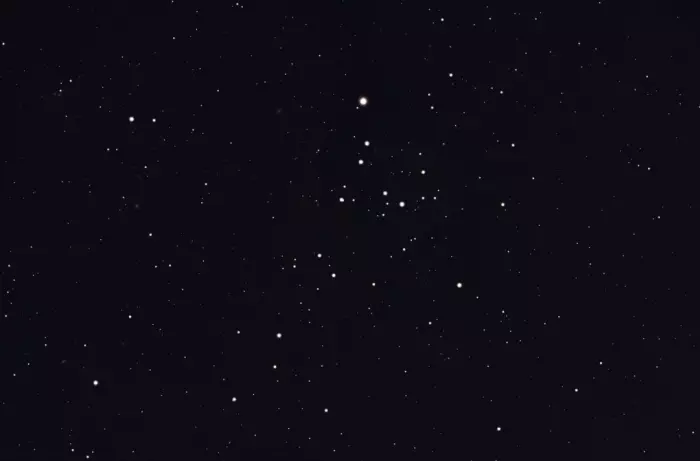
The Coma Star Cluster, image credit: Roberto Mura, Stellarium (CC BY-SA 3.0)
Stars
The Coma Berenices Cluster contains about 14 stars brighter than magnitude 6.5, which is the limit of unaided eye visibility.
Gamma Comae Berenices, the third brightest star in Coma Berenices, appears as the brightest star in the cluster but is not really a member. The orange giant star shines at magnitude 4.36 from a distance of 169 light-years, which places it in the foreground of the cluster. The star’s estimated age is about 2.72 billion years.
The binary star system 12 Comae Berenices is the brightest confirmed member of the cluster. It has an apparent magnitude of 4.80 and lies 276 light-years away. The system is composed of an F-type giant and an A-type main sequence star locked in a 396.54-day orbit. The primary component has a mass of 2.6 solar masses and the secondary, 2.05 solar masses. The stars are 56.2 and 30.2 times more luminous than the Sun.
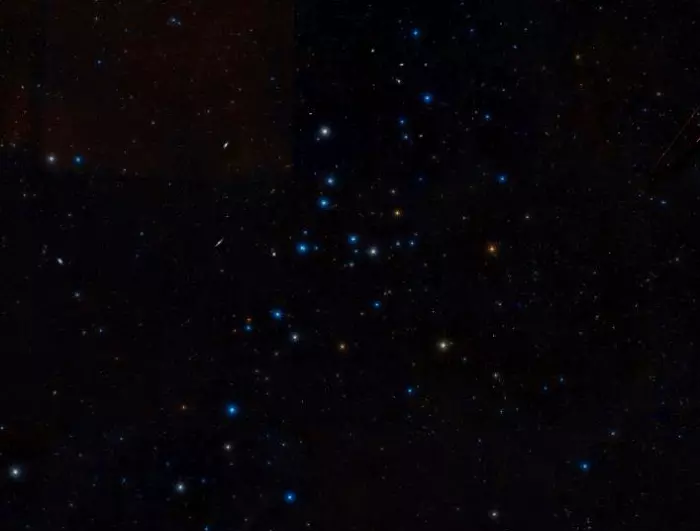
Coma Berenices Cluster, image: Wikisky
The variable yellow giant 31 Comae Berenices is the second-brightest member of the cluster. It has an apparent magnitude of 4.87 – 4.97 and lies 284 light-years away. The giant star is informally known as Polaris Galacticum Borealis as the nearest visible star to the north galactic pole. The star is an exceptionally fast spinner and has an ellipsoidal shape as a result of its fast rotation rate. It is classified as an FK Comae Berenices variable, a variable star whose brightness fluctuates due to star spots coupled with the effects of rotation.
Two other stars in the cluster shine brighter than magnitude 5.0. 14 Comae Berenices has an apparent magnitude of 4.95 and 16 Comae Berenices, 4.96.
14 Comae Berenices is a shell star that spins with a projected rotational velocity of 226 km/s. Like 31 Com, it has an oblate shape and an equatorial bulge. The star has a mass 2.4 times that of the Sun and is 76.01 times more luminous than our star. Its estimated age is about 500 million years.
16 Comae Berenices lies 279 light-years away. It is an A-type main sequence star with an orbiting debris disk at a mean distance of 18.2 astronomical units. The star has a mass of about 2.54 solar masses and shines with 68.6 solar luminosities. It has an estimated age of 310 million years and spins at 80 km/s.
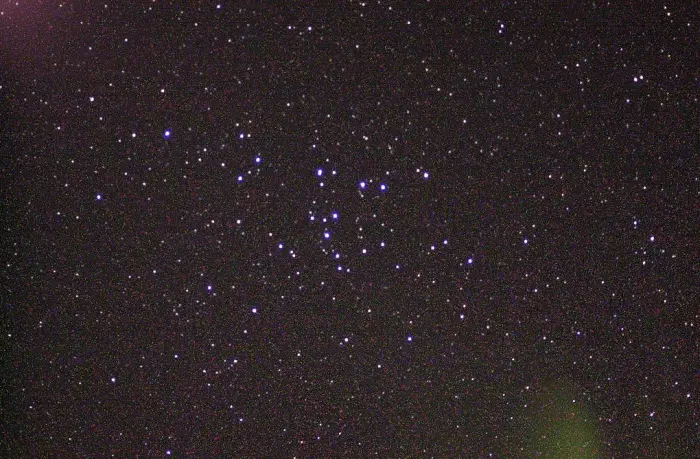
The Coma Star Cluster, a collection of stars which are visible to the unaided eye in the constellation Coma Berenices, is visible in this view photographed by astronaut Donald R. Pettit, Expedition Six NASA ISS science officer, on board the International Space Station (ISS). The Coma Cluster is visible as a faint fuzzy patch between the constellations Leo and Virgo. The unaided eye cannot resolve the individual stars, but collectively, they merge into a fuzzy flow in this part of the sky. Image credit: NASA/Donald R. Pettit
Facts
The Coma Star Cluster has been known as an unaided-eye object since ancient times. However, due to its exceptionally large apparent size and loose appearance, it was not included in the Messier catalogue, New General Catalogue, Index Catalogue, or Caldwell catalogue. The grouping was not proved to be a true star cluster until 1938, when Swiss-American astronomer Robert J. Trumpler identified 37 members, showing that the stars were physically related and not just a line-of-sight coincidence.
The Coma Berenices Cluster was nevertheless given the designation Melotte 111 in the Melotte catalogue of 245 star clusters, compiled by the British astronomer Philibert Jacques Melotte in 1915. It was also catalogued by Swedish astronomer Per Collinder in his 1931 catalogue of open clusters.
The Coma Star Cluster is one of the nearest open clusters to the Sun. The distance of 280 light-years was established using Hipparcos satellite data combined with infrared colour-magnitude fitting, and later confirmed by independent studies. Only the Hyades cluster in the constellation Taurus is closer. Representing the head of the Bull, it lies at a distance of 153 light-years.
Melotte 111 is sometimes also known as the Coma Berenices Cluster, Ariadne’s Hair, the Cobweb Cluster, Thisbe’s Veil, Black Bart’s Hair, and the Flying Witch. It is usually not referred to as the Coma Cluster to avoid confusion with the Coma Cluster of galaxies (Abell 1656), a large cluster that contains more than a thousand confirmed member galaxies.
The Coma Berenices Cluster historically represented the tuft of hair on the tail of the celestial Lion. However, its stars were split off into a separate constellation, Coma Berenices, by the Egyptian pharaoh Ptolemy III Euergetes around 240 BCE. Ptolemy III named the constellation Coma Berenices, meaning Berenice’s Hair, to honour his consort, Queen Berenice II of Egypt, who famously sacrificed her long hair for her husband’s safe return from battle. Ptolemy’s court astronomer Conon of Samos is credited for introducing the constellation to Western astronomy.
In spite of its ancient origin, Coma Berenices is not considered one of the 48 Greek constellations. Ptolemy of Alexandria, who catalogued the ancient constellations in his Almagest in the 2nd century CE, considered the stars of Berenice’s Hair to be part of Leo. He called these stars Plokamos, meaning “the tuft of hair.” Coma Berenices was mostly seen as an asterism until the 16th century, when it began appearing on celestial maps and globes as a separate constellation.
In modern astronomy, the Lion’s tail is represented by Denebola (Beta Leonis), the second brightest star in Leo.
Location
The Coma Berenices Cluster is easy to find because it appears within the Diamond of Virgo (Great Diamond), a conspicuous asterism that dominates the northern spring sky. The Diamond of Virgo is formed by Arcturus in Boötes, Spica in Virgo, Cor Caroli in Canes Venatici, and Denebola in Leo. The cluster lies about halfway between Cor Caroli and Denebola.
Cor Caroli can be identified using the stars of the Big Dipper in Ursa Major. The star appears below Alkaid, the star at the tip of the Dipper’s handle (or the Great Bear’s tail). Denebola marks the tail of the Lion and is part of the constellation figure of Leo.
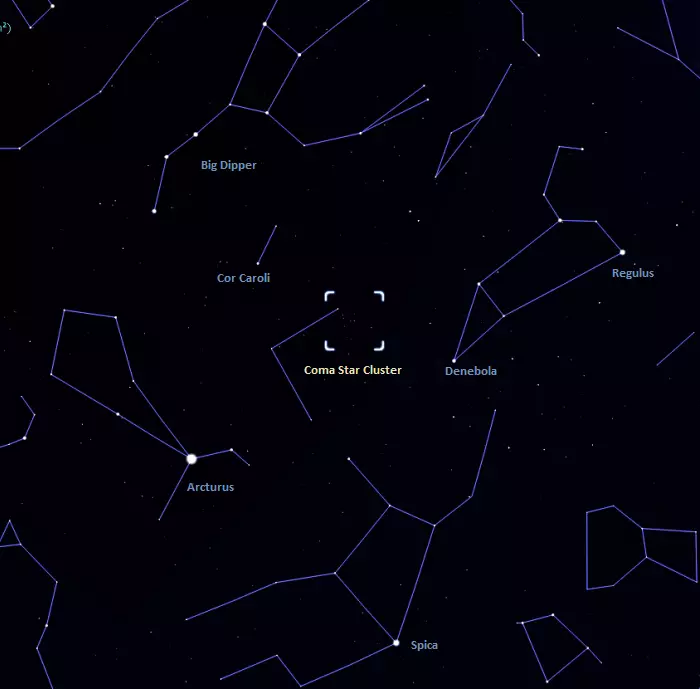
The location of the Coma Berenices Cluster, image: Stellarium
Several relatively bright galaxies appear near the Coma Star Cluster, including the Needle Galaxy (NGC 4565), the spiral galaxy NGC 4559, the barred spiral galaxy NGC 4725, and the elliptical galaxy NGC 4494. These galaxies are members of the Coma I Group, a group of galaxies located approximately 47.3 million light-years away.
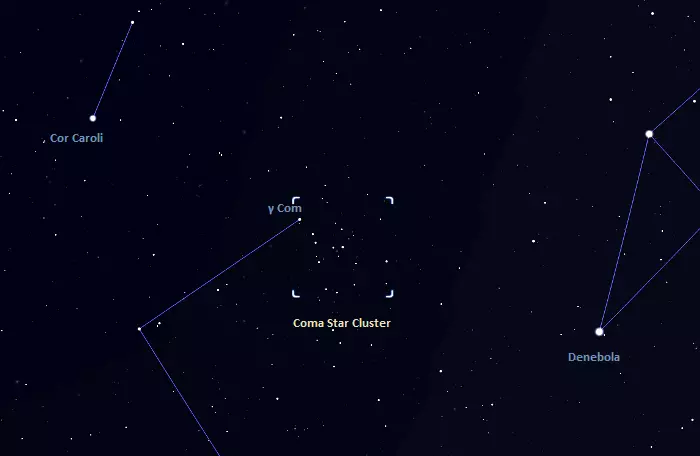
Coma Star Cluster location, image: Stellarium
The best time of the year to observe the Coma Star Cluster and other deep sky objects in Coma Berenices is during the month of May, when the constellation is high above the horizon in the evening. The cluster is one of the easiest targets for amateur astronomers. It is best observed in small binoculars or in a small telescope at low magnification. It requires a clear, dark sky to be seen without visual aids.
Coma Star Cluster – Melotte 111
| Constellation | Coma Berenices |
| Right ascension | 12h 24m 03.4s |
| Declination | +25° 39′ 07′′ |
| Apparent magnitude | 1.8 |
| Apparent size | 7.5° |
| Distance | 280 light-years (86 parsecs) |
| Names and designations | Coma Star Cluster, Coma Berenices Cluster, Melotte 111, Collinder 256, OCl 558.0 |